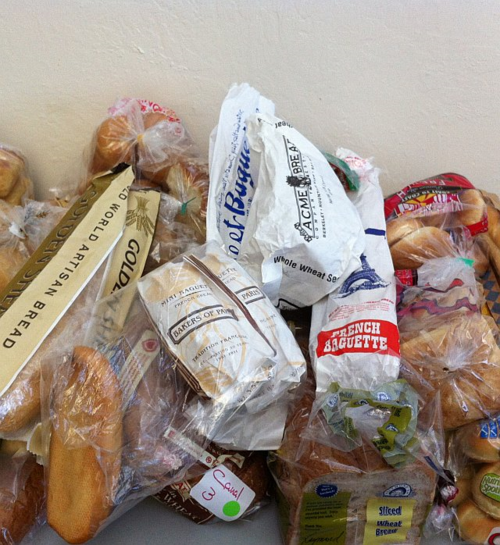
What's the most critical thing to making authentic banh mi? Many people think it's the bread. In fact, while in Seattle last week, I had the opportunity to hang out at the brainy headquarters of ChefSteps, a website for people who enjoy the geeking out on cooking technique and science. There’s a lot of molecular gastronomy and experimentation at the ChefSteps test kitchen where I met my friends Michael Natkin and Lorraine Easterling. We sat down to chat with founder Chris Young, who turned out to be super into bread. Our conversation quickly turned to the ideal bread for banh mi.
Chris pointed out that when my friend Eric Banh opened Baguette Box in Seattle, his bread was so rustic and hard that it scraped the roof of Chris’s mouth. It was awful and wrong for banh mi, Chris said, and he was right.
Banh Mi Bread Buying Tip 1: A well-crafted banh mi that uses great ingredients may cost you more than you think. However, pricey rustic breads with a strong, thick crust and toothsome chew do not work well for banh mi. They may scrape the roof of your mouth as you eat and/or mute the myriad ingredients inside; the filling may squirt out because it does not hug and encase the filling well. Such breads are good for many applications but not for Vietnamese sandwiches.
Eric admitted so to me years ago, and he quickly sourced a better chewy-crisp and light baguette for his banh mi from a French bakery called Le Panier. The local Vietnamese bakeries made bread that was way too light and didn’t stand up to his bold fillings, Eric felt. I heard similar sentiments from the owner of Sing Sing banh mi shop in San Francisco; Harry Lum opts for slightly dense rolls. That super light bread isn't the only game in town when it comes to selecting what frames your Vietnamese sandwich.
Banh Mi Bread Buying Tip 2: Don’t get stuck thinking that there’s only one type of bread for making Viet sandwiches. What’s typically used is a baguette-style bread, either sections cut from a long one or an individual petite-size roll. However, you can try sliced bread too so long as it's got the right light texture and faintly sweet flavor profile to accept and match the rich mayo, salty Maggi Seasoning sauce, flavorful fillings, crisp vegetables, spritely herb, and bright chile.
Chris also asked me about rice flour in Vietnamese baguette-style bread. He suggested that it added little crunch. Yes, that’s true but you can’t add more than just a tiny bit – several tablespoons as I found out when writing the bread recipe for the book. When a large amount of rice flour is used, Chris pointed out, the bread does not brown well. I totally concur.
Plus without enough gluten, bread that has a lot of rice flour also does not rise well and is dense. Here’s a photo of bread baked from a published recipe I found that that called for a 1 cup of rice flour and 4 ½ cups of all-purpose flour.
There was yeast and baking powder but the result was dense and not pretty. It didn’t resemble Vietnamese baguette as the recipe was called. I discarded the entire batch of 8 rolls.
Years ago, a baker from the Modesto, California, told me that a little rice flour was used in Vietnam to absorb humidity. I tinkered and baked everyday for months and found that small amounts of rice flour didn’t make a huge difference in my recipe.
Banh Mi Bread Buying Tip 3:The bread does not have to have rice flour to be legit Vietnamese-style baguette for banh mi.
When finally I found Vietnamese bread baker who would show me his ingredients, I discoverd there was no rice to be found. Ngoc Bui, a third-generation baker, used flour, yeast, sugar and water. Nothing more than those simple ingredients, though I noted that his professional grade flour label included dough conditioners in the listing.
Chris and I ended up chatting about dough enhancers and dough conditioners, which are often added to commercial flour to ensure a perfect rise. Bakers choose their flours wisely and may or may not realize that their flours include enhancements such as ascorbic acid (vitamin C, aids rise) and DATEM (Diacetyl Tartaric Acid Esters of Monoglycerides, adds structure ). They’re busy baking.
While writing the book, I would find suitable banh mi bread, such as bolillo rolls, and scan the ingredient list. There was DATEM. One local baguette had ascorbic acid. Other breads included vital wheat gluten and ascorbic acid. Though DATEM is considered safe food additive, some people deem it untrustworthy. Whole Foods does not carry products that contain it. It’s not sold to home cooks so it’s out of our realm but good to know what it does to our food.
The breads that often used these enhancers and conditioners tend to not cost a lot, I found during the course of writing the book. The rolls and baguettes are pretty light and the price is always right! They were around you -- at supermarkets, bodegas, and ethnic enclaves. Rarely was the bread an artisanal, chic thing.
Banh Mi Bread Buying Tip 4: Bread suitable for banh mi is rather plebian stuff that’s pretty easy to find. Freshly baked bread works the best. Look in the bulk bins and baskets. Mine the markets big and small around you.
The takeaway of my conversation at ChefSteps is that smart cooks pay attention to tiny clues. You don’t have to be a geek about it (neither Chris nor I could remember what DATEM stood for), but keep in mind certain parameters when shopping and cooking and you'll go far. Morevoer, that the bread is part of the banh mi equation but there is lattitude for what to use.
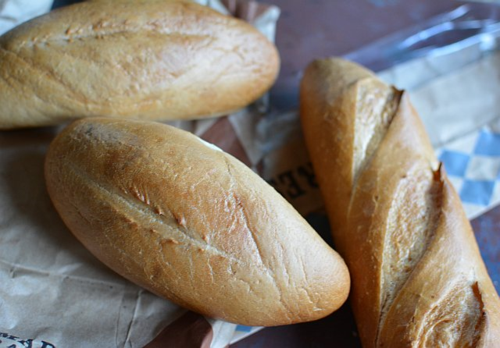
Summary of pointers from The Banh Mi Handbook's “Bread Buying Guide”:
Where to shop Supermarkets, ethnic grocers, bakeries, delis, bodega-style convenience stores
Type of bread Roll or loaf, sometimes sliced bread
Bread characteristics
- Feels relatively light when picked up
- Has a delicate (thin) crust
- Possesses a tender, chewy-soft interior (press on it and it should lazily bounce back)
- Tastes faintly sweet
- Is considered everyday, affordable bread
Examples of breads that work well
- “French” or “Italian” rolls or loaves sold at supermarkets
- “Baguette” at Chinese, Vietnamese markets, bakeries, and delis
- Mexican bolillo or telera rolls
- Cubano rolls
- Ciabatta rolls or loaves
- Partially baked (parbaked) rolls or loaves of French, Italian, or Ciabatta-style bread (follow instructions to finish baking)
- Kaiser rolls
- Hoagie or cheesesteak roll
- Sandwich bread (white, wheat, multigrain, or gluten-free)
- Mini slider buns
A Non-Banh-Mi-Bread-Buying Tip: If your roll or baguette is lifeless, rub a little water on the outside before reheating in the toaster oven at 350F (180/175C). It'll crisp up like a charm. Have any tips to add or questions to ask? Share them below.
P.S. Voting for the winners of the banh mi selfie contest has begun! Check out the terrific entries (from the US., Canada, Australia and Paris) and help select the five winners. You can vote daily till October 5!
P.P.S. If you're in Los Angeles, I have events there coming up. This weekend, though, I'm on the radio which you can listen to from anywhere! Hope to meet you in person:













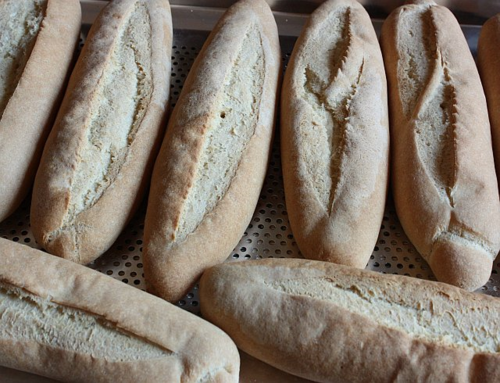


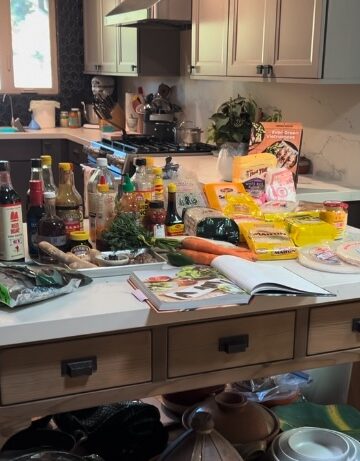
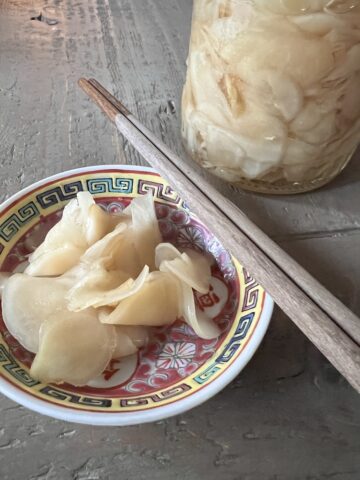
Thuy Nguyen says
I have done research trying to find a warehouse selling vietnamese bread flour in USA. Do you know any where? Can you show me please???
Andrea Nguyen says
To my knowledge, Viet bakers are using American flour for their bread. You need to find the right flour. It is flour that is highly conditioned -- with an additive to create a super big rise. There are many different kinds so explore sites like General Mills. King Kaiser may work: https://www.generalmillscf.com/products/category/flour/hard-spring-wheat/king-kaiser-bleached-ascorbic-acid-enriched-malted-50lb